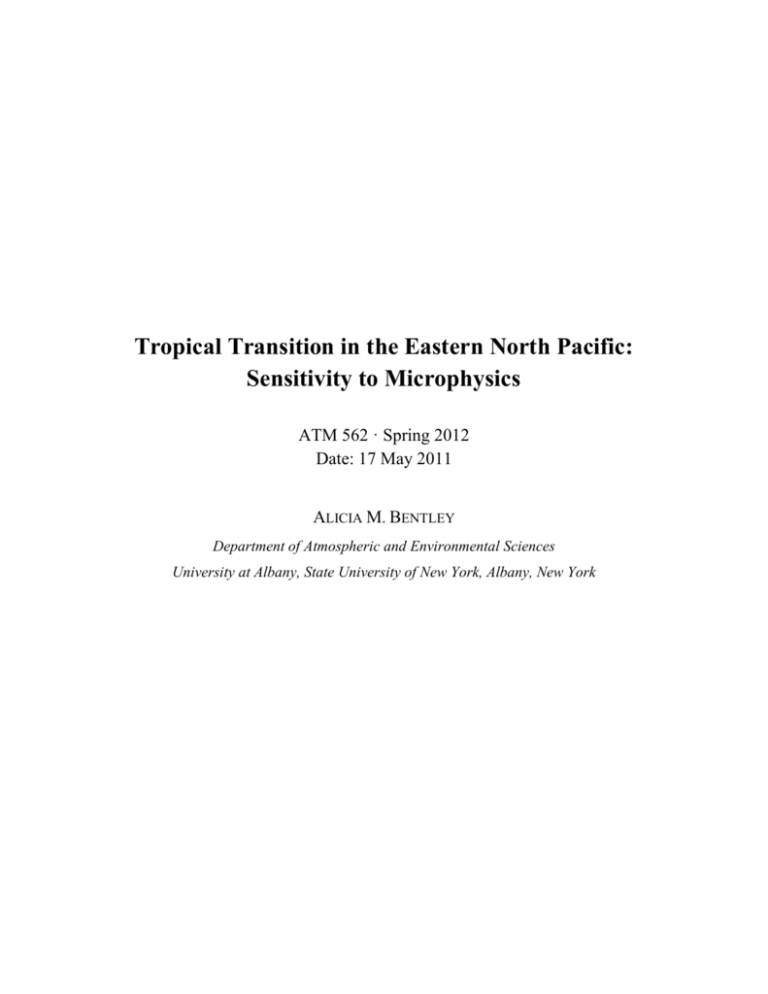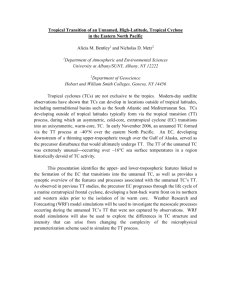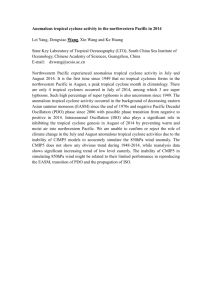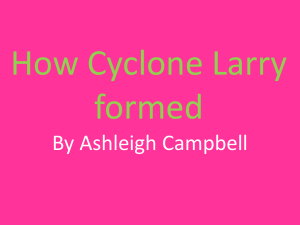A Preliminary Climatology of Tropical Moisture Exports in the
advertisement

Tropical Transition in the Eastern North Pacific: Sensitivity to Microphysics ATM 562 · Spring 2012 Date: 17 May 2011 ALICIA M. BENTLEY Department of Atmospheric and Environmental Sciences University at Albany, State University of New York, Albany, New York 2 Abstract Date: 17 May 2011 Tropical cyclones are not exclusive to the tropics. The advent of satellite observations has resulted in the documentation of axisymmetric, warm core, cyclones over what are typically considered to be inhospitable basins. Such systems often develop from existing extratropical cyclones via the tropical transition (TT) process. An unnamed tropical cyclone (hereafter Invest 91C) underwent TT and developed in the eastern North Pacific in late October 2006. The present study simulates the TT of Invest 91C using the Weather Research and Forecasting (WRF) model and investigates the structural differences that arise from changing the complexity of the microphysics scheme. The three microphysics schemes considered in this study include the: 1) WRF single-moment 6-class (WSM6), 2) WRF single-moment 3-class (WSM3), and 3) Kessler scheme. All schemes produce warm core cyclones of varying depth and intensity. Utilization of Kessler results in the deepest cyclone produced by any of the analyzed schemes. WSM3 yields the solution with the greatest low-level wind speed and the largest 850 hPa absolute vorticity value. The microphysical assumptions made within Kessler and WSM3 cause them to display highly inaccurate representations of the outgoing longwave radiation field. This work demonstrates that increasing the complexity of the microphysics scheme improves the overall solution, making it more consistent with observations of the event. 3 1. Introduction Tropical cyclones are not exclusive to the tropics. While the favorable conditions for tropical cyclogenesis identified by Gray (1968) and evaluated by DeMaria et al. (2001) are more frequently observed at tropical latitudes, conditions can become conducive for genesis in locations removed from the equatorial region. Axisymmetric, warm core, cyclones have been documented in several atypical basins, including over the western South Atlantic Ocean (McTaggart-Cowan et al. 2006) and Mediterranean Sea (Ernst and Matson 1983; Pytharoulis et al. 1999; Reale and Atlas 2001). The development of tropical cyclones within these regions is often associated with the tropical transition (TT) of an existing extratropical cyclone (Davis and Bosart 2003, 2004). Upper-level trough forcing and convectively driven diabatic potential vorticity (PV) act to enhance the strength of the mesoscale convective vortex (MCV) and reduce near-storm vertical wind shear, resulting in tropical cyclogenesis via the TT process (McTaggartCowan et al. 2008). In late October 2006, an unnamed tropical cyclone (hereafter Invest 91C) developed at ~40°N over the eastern North Pacific Ocean (Fig. 1a). A baroclinic cyclone, forming in association with a thinning midlatitude trough in the Gulf of Alaska, served as the precursor disturbance that would ultimately undergo TT. Convection associated with a bent-back frontal structure upstream of the system at 1200 UTC 29 October induced PV ridging and lowered vertical wind shear values near the storm center (not shown). The cyclone became occluded, removed from the upper-level jet, and developed a warm core by 1200 UTC 1 November (Fig. 1b). The entire process occurred over unusually cold sea surface temperatures (~16°C) in a region historically devoid of tropical cyclone activity. Model simulations of the TT of Invest 91C are performed in this study, utilizing version 4 3.4 of the Weather Research and Forecasting (WRF) modeling system (Shamarock et al. 2001, 2007). The present paper attempts to identify variations in the structure and intensity of Invest 91C that result from the use of different microphysical schemes within the model. Information on model configuration, as well as the data and methodology used in this study, will be presented in the following section. Section 3 will discuss specific findings from the investigation, including the observed differences between model runs. This paper will conclude with a brief discussion and presentation of ideas for future research. 2. WRF configuration The WRF V3.4 was initialized with 1° Global Forecast System (GFS) analysis data obtained from the National Oceanic and Atmospheric Administration (NOAA) National Operational Model Archive & Distribution System (NOMADS). All simulations begin at 1200 UTC 29 October and end at 1200 UTC 1 November. A two-way nested grid is used in this study with 30 km (10 km) horizontal resolution within the outer (inner) nest (Fig. 2). Thirty five vertical levels are analyzed. The WRF physics package allows the user to employ numerous combinations of cumulous, land surface, planetary boundary layer, and microphysical parameterization schemes. All simulations use the Kain-Fritsch cumulous parameterization scheme (Kain and Fritsch 1993), Noah land surface scheme (Shamarock et al. 2008), and Mellor-Yamada-Janjic TKE planetary boundary layer scheme (Mellor and Yamada 1982). This is done to isolate the impact of varying the microphysical parameterization (MP) scheme. The warming of the core of a tropical cyclone is usually due to a combination of the diabatic heating in the eyewall and dry adiabatic descent within the eye. It is possible that 5 changes in the structure of the core of the cyclone may be sensitive to the distribution of diabatic heating and, therefore, the MP scheme used (Stern and Nolan 2012). Three simulations are performed in this study, each with a different MP scheme. Simulations are run with either the WRF Single-Moment 6-class (WSM6) (Hong and Lim 2006), WRF Single-Moment 3-class (WSM3) (Dudhia 1989; Hong et al. 2004), or Kessler (Kessler 1969) MP scheme, consistent with the simulations by Stern and Nolan (2012). WSM6 has the highest complexity, predicting six categories of hydrometers: vapor, rain, snow, cloud ice, cloud water, and graupel. WSM3 is simplified, predicting three categories of hydrometers: vapor, cloud water/cloud ice, and rain water/snow. Melting (freezing) occurs instantaneously at temperatures above (below) freezing. WSM3 is often referred to as a “simply ice” scheme in which liquid and solid water cannot coexist. The Kessler MP scheme is a warm cloud scheme that includes vapor, cloud water, and rain. The only mechanism that produces new precipitation in the Kessler parameterization is the autoconversion process. Kessler is the simplest and most unrealistic of the three schemes considered in this study. 3. Structural differences It is often necessary for model output to be compared to surface observations and/or satellite data from the analyzed event to test the accuracy and validity of the solution. There is an unfortunate lack of radar coverage, upper air data, and surface observation stations over the portion of the Pacific Ocean where Invest 91C was documented. For this reason, the output fields analyzed in this study will be compared to surface analyses from the National Centers for Environmental Prediction (NCEP) and archived GOES-11 infrared (IR) imagery from the Cooperative Institute of Meteorological Satellite Studies’ (CIMSS) satellite blog, available 6 online at http://cimss.ssec.wisc.edu/goes/blog/archives/211. Maximum reflectivity (dBZ) and mean sea level pressure (MSLP) (hPa) values from the final output time of each model run (1200 UTC 1 November) are shown in Fig. 3. The corresponding IR imagery and surface analysis are depicted in Figs. 3d and 3e, respectively. All three MP schemes correctly identified the asymmetry in convection around the cyclone center, with the region of the highest maximum reflectivity to the north of the vortex mirroring an area of markedly cooler cloud tops in the IR panel. All three simulations highlight, to varying degrees, the remnants of an occluded frontal feature that extends from just west of the cyclone center outward to the north and east. The final position of the center of circulation is remarkably similar in all MP schemes (~41.5°N, 146°W) and is consistent with observations. The Kessler MP scheme produces the deepest surface cyclone (<984 hPa) (Fig. 3c). In contrast, the NCEP surface analysis indicates a minimum central pressure of only 988 hPa. Despite the discrepancy with the NCEP final analysis, there is insufficient observational evidence to prove that Kessler has overestimated the central pressure of Invest 91C. Figure 4 depicts 700 hPa height (m), temperature (°C), and wind (m s-1) at 1200 UTC 1 November. All three MP schemes indicate a warm core cyclone at 700 hPa. This warm core extends above 500 hPa in each model simulation (not shown). The asymmetry illustrated in the wind field matches that of convection, with the fastest winds consistently to the north of the cyclone center. The Kessler scheme continues to produce the deepest cyclone with the warmest core (Fig. 4c). Despite having a weaker warm core, WSM3 produces the strongest radial temperature gradient and the fastest wind speeds about the cyclone center (Fig. 4b). The absolute vorticity and vector wind field at 850 hPa reinforces this assessment at lower levels (Fig. 5). Figure 5 also reiterates the consistent placement of the center of circulation three days 7 after model initialization. The highest absolute vorticity values are removed from the center of the vortex in both WSM3 and Kessler, likely due to small-scale processes that cannot be resolved with 10 km horizontal resolution. Figure 6 depicts model derived outgoing longwave radiation (OLR) (W m-2) at 1200 UTC 1 November. WSM6 and WSM3 correctly identify the asymmetry observed in the cold cloud tops in the corresponding IR image (Fig. 6d). While the overall spiral structure of the OLR field is relatively similar between the two schemes, WSM3 has consistently warmer cloud tops. This is likely a result of how hydrometers are separated within each MP scheme. Only identifying three classes of hydrometers (vapor, cloud water/ice, and rain water/snow) could result in a reduction in condensate at upper levels in WSM3 and an overall warmer solution (Fig. 6b). WSM6 yields the solution that most closely resembles the few available observations of the event. The WRF simulation that utilizes the Kessler MP scheme produces a highly unrealistic solution in the OLR field (Fig. 6c). A vast expanse of cold cloud tops (exceeding 90 W m-2 in some regions) covers the majority of the domain. These cloud tops do not correspond to regions of convection, as the simulated maximum reflectivity field did not display such structure. The answer lies in the assumptions embedded within the MP scheme itself. New precipitation particles in the Kessler parameterization can only be produced by the autoconversion process. Autoconversion will not occur unless a critical concentration of cloud droplets is exceeded. Fovell et al. (2009) suggest that the typical updraft speeds observed in tropical cyclones produce less condensation than continental convection, a smaller droplet concentration, and, therefore, fewer new raindrops in the Kessler MP scheme. The unrealistic feature observed in the OLR field is likely an extensive anvil cloud. Figure 8, adapted from Fovell et al. (2009), displays 8 vertical cross sections of the condensate distribution in tropical cyclones utilizing either Kessler or the WSM3 MP scheme. Kessler exhibits considerably more condensate above 10 km than WSM3, likely manifesting itself as the spurious OLR field observed in the present study. 4. Discussion and Conclusions The results of this analysis indicate that the structure of Invest 91C is somewhat sensitive to the complexity of the MP scheme used to model the cyclone as it undergoes TT. Many similarities in cyclone structure are observed across the three simulations. All three MP schemes considered (WSM6, WSM3, and Kessler) produce warm core cyclones by 1200 UTC 1 November with warm core signatures evident upwards of 500 hPa. All simulations also accurately capture the asymmetry in convection about the cyclone center, with the deepest convection and the strongest winds predominantly on the northern side of the vortex. Subtle differences in the magnitude of the analyzed fields highlight the effects of the different MP schemes. The Kessler parameterization produces the deepest cyclone (~4 hPa deeper than either WSM6 or WSM3) with the warmest core at all analyzed levels. Despite having a weaker warm core, the steep radial temperature gradient observed in WSM3 produces the strongest low-level winds and largest absolute vorticity values of any simulation. The greatest disparity that results from the use of different MP schemes can be seen in the OLR field (Fig. 6). The WSM6 parameterization produces the most realistic solution that is also the most consistent with the corresponding IR imagery. WSM3 captures the overall structure of the WSM6 OLR field, but fails to produce sufficiently cold cloud tops in regions removed from north of the cyclone center. The Kessler parameterization scheme produces the most unlikely solution, with the vast majority of the domain covered in an expansive cloud field. The simple 9 representation of precipitation formation in Kessler causes condensates, once lofted into the upper troposphere, to remain there. The result is the formation of the extensive and unrealistic anvil seen in Fig. 6c. The methodologies used in this study could be expanded upon to offer further insight into the structural differences that arise from changing the complexity of the MP scheme. Performing a similar analysis at a higher resolution would provide a more detailed look at these structural disparities. Newer, more state of the art, MP schemes should also be incorporated into the investigation, specifically the Thompson MP scheme (Thompson et al. 2004). The same methodologies utilized here could also be applied to an entirely different event over the continental United States. This would increase the likelihood of obtaining the surface observations, ground-based radar products, and upper-air data necessary to compare WRF model output against. Acknowledgments. The author of this paper would like to thank Kevin Tyle (Department of Atmospheric and Environmental Sciences (DAES), University at Albany) for his technical assistance, patience, and generosity throughout this research process. The results and figures presented in this paper would not have been possible without the assistance of Nick Metz (Department of Geoscience, Hobart and William Smith Colleges) or the NCAR Command Language (NCL) scripts provided by Derek Mallia (Department of Atmospheric Sciences, University of Utah). This work also benefitted greatly from discussions with Kristen Corbosiero (DAES, University at Albany). 10 References Davis, C., and L. F. Bosart, 2003: Baroclinically induced tropical cyclogenesis. Mon. Wea. Rev., 131, 2730–2747. , and , 2004: The TT problem. Bull. Amer. Meteor. Soc., 85, 1657–1662. DeMaria, M., J. A. Knaff, and B. H. Connell, 2001: A tropical cyclone genesis parameter for the tropical Atlantic. Wea. Forecasting, 16, 219– 233. Dudhia, J., 1989: Numerical study of convection observed during the winter monsoon experiment using a mesoscale two-dimensional model. J. Atmos. Sci., 46, 3077-3107. , S.-Y. Hong, and K.-S. Lim, 2008: A new method for representing mixed-phase particale fall speeds in bulk microphysics parameterizations. J. Met. Soc. Japan, 86A, 33-44. Ernst, J. A., and M. Matson, 1983: A Mediterranean tropical storm? Weather, 38, 332-337. Fovell, R. G., K. L. Corbosiero, and H.-C. Kuo, 2009: Cloud microphysics impact on hurricane track as revealed in idealized experiments. J. Atmos. Sci., 66, 1764-1778. Gray, W. M., 1968: Global view of the origin of tropical disturbances and storms. Mon. Wea. Rev., 96, 669-700. Hong, S.-Y., J. Dudhia, and S.-H. Chen, 2004: A revised approach to ice microphysical processes for the bulk parameterization of clouds and precipitation. Mon. Wea. Rev., 132, 103–120. , and J.-O. J. Lim, 2006: The WRF single-moment 6-class microphysics scheme (WSM6). J. Korean Meteor. Soc., 42, 129–151. , and Y. Noh, and J. Dudhia, 2006: A new vertical diffusion package with an explicit treatment of entrainment processes. Mon. Wea. Rev., 134, 2318–2341. Hulme, A. L., and J. E. Martin, 2009: Synoptic- and frontal-scale influences on tropical transition events in the Atlantic basin. Part II: Tropical transition of Hurricane Karen. Mon. Wea. Rev., 137, 3626–3650. Kain, J. S., and J. M. Fritsch, 1993: Convective parameterization for mesoscale models: The Kain–Fritsch scheme. The Representation of Cumulus Convection in Numerical Models, Meteor. Monogr., No. 46, Amer. Meteor. Soc., 165–170. Kessler, E., 1969: On the distribution and continuity of water substances in atmospheric circulation, Meteor. Monogr., 32, Amer. Meteor. Soc., 88 pp. McTaggart-Cowan, R., L. F. Bosart, C. A. Davis, E. H. Atallah, J. R. Gyakum, and K. A. Emanuel, 2006: Analysis of Hurricane Catarina (2004). Mon. Wea. Rev., 134, 3029–3053. 11 , G. D. Deane, L. F. Bosart, C. A. Davis, T. J. Galarneau, 2008: Climatology of tropical cyclogenesis in the North Atlantic (1948−2004). Mon. Wea. Rev., 136, 1284–1304. Mellor, G. L., and T. Yamada, 1982: Development of a turbulence closure model for geophysical fluid problems. Rev. Geophys. Space Phys., 20, 851-857. Pytharoulis, I., G. C. Craig, and S. P. Ballard, 1999: Study of the hurricane-like Mediterranean cyclone of January 1995. Phys. Chem. Earth, 24B, 627–632. Reale, O., and R. Atlas, 2001: Tropical cyclone-like cortices in the extratropics: Observational evidence and synoptic analysis. Wea. Forecasting, 16, 7-34. Skamarock, W. C., J. B. Klemp, and J. Dudhia, 2001: Prototypes for the WRF (Weather Research and Forecasting) model. Preprints, Ninth Conf. on Mesoscale Processes, Fort Lauder- dale, FL, Amer. Meteor. Soc., CD-ROM, J1.5. , and J. B. Klemp, 2007: A time-split non- hydrostatic atmospheric model for research and NWP applications. J. Comput. Phys., 135, 3465–3485. Stern, D. P., D. S. Nolan, 2012: On the height of the warm core in tropical cyclones. J. Atmos. Sci., 69, 1657-1680. Thompson, G., R. M. Rasmussen, and K. Manning, 2004: Explicit forecasts of winter precipitation using an improved bulk microphyics scheme. Part I: Description and sensitivity analysis. Mon. Wea. Rev., 132, 519–542. 12 FIG. 1. (a) GOES-10 visible satellite image from 0045 UTC 2 Nov 2006 showing the unnamed Pacific storm about 1100 km off the coast of Oregon. (b) Vertical cross section along line D–D’ is shown. Sea surface temperatures beneath the storm were ~16°C. (b) Vertical cross section along line D–D’ in (a) of θe, θ and PV from the 0000 UTC 2 Nov 2006 National Center for Environmental Prediction (NCEP) final analysis. The quantity θe is labeled in K and contoured every 1 K. Tropospheric PV is shaded in increments of 0.1 PVU beginning at 0.7 PVU. Thick black lines are upper-tropospheric/lower-stratospheric PV labeled in PVU and contoured every 1.5 PVU beginning at 1.5 PVU. Thin gray lines are θν isentropes labeled in K and contoured every 3 K. “L” represents the position of the SLP minimum along the cross section. [Adapted from Fig. 18 in Hulme and Martin, 2009] 13 Domain British Columbia 50°N 40°N 30°N 160°W 150°W 140°W 130°W FIG. 2. Pictorial representation of the WRF domains used in this study. The only landmass in the domain, British Columbia, is indicated in the upper right corner. 14 1200 UTC − 1 November 2006 WSM6 a ) WSM3 b ) Kessler c ) Observation d ) Infrared (°C) Red contours: MSLP (hPa) 40°N NWS/NCEP Pacific Surface Analysis 150°W e ) 140°W Yellow contours: MSLP (hPa) FIG. 3. Comparison of model derived maximum reflectivity (dBZ, shaded) and MSLP (hPa, red contours) from the a) WSM6, b) WSM3, and c) Kessler simulations with d) GOES-11 IR imagery (°C, shaded) and e) surface analysis (MSLP [hPa, yellow contours]) of Invest 91C at 1200 UTC 1 November 2006. GOES-11 IR image obtained courtesy of the Cooperative Institute of Meteorological Satellite Studies (CIMSS). Surface analysis obtained courtesy of the National Centers for Environmental Prediction (NCEP). 15 a ) b ) c ) d ) FIG. 4. Comparison of model derived 700 hPa heights (m, blue contours), temperature (°C, red contours), and winds (barbs) from the a) WSM6, b) WSM3, and c) Kessler simulations with d) GOES-11 IR imagery (°C, shaded) of Invest 91C at 1200 UTC 1 November 2006. GOES-11 IR image obtained courtesy of the Cooperative Institute of Meteorological Satellite Studies (CIMSS). 16 a ) bb )) c ) dd )) FIG. 5. Comparison of model derived 850 hPa absolute vorticity (s-1, shaded) and vector wind (m s-1) from the a) WSM6, b) WSM3, and c) Kessler simulations with d) GOES-11 IR imagery (°C, shaded) of Invest 91C at 1200 UTC 1 November 2006. GOES-11 IR image obtained courtesy of the Cooperative Institute of Meteorological Satellite Studies (CIMSS). 17 1200 UTC − 1 November 2006 WSM6 a ) WSM3 b ) Kessler c ) Observation d ) Infrared (°C) FIG. 6. Comparison of model derived OLR (W m-2, shaded) from the a) WSM6, b) WSM3, and c) Kessler simulations with d) GOES-11 IR imagery (°C, shaded) of Invest 91C at 1200 UTC 1 November 2006. GOES-11 IR image obtained courtesy of the Cooperative Institute of Meteorological Satellite Studies (CIMSS). 18 Kessler a ) WSM3 b ) FIG. 7. Vertical cross sections of condensate kg-1; shaded)(gand temperature perturbations Vertical cross sections of(gcondensate kg-1virtual ; shaded) (K; contoured) fromand the virtual initial state of the model simulation using the a) temperature perturbations from the initialKessler and b) WSM3 microphysics parameterization schemes. [Adapted fromFovell Fig. 7 et in al. Fovell et al., 2009] state (K; contoured) [Fig. 7 from 2009]








